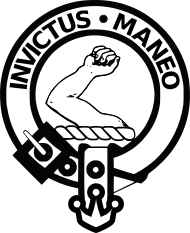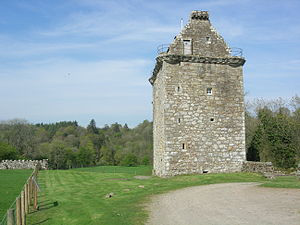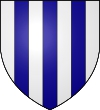
According to the legend and tradition, the first of the name Armstrong was Siward Beorn (sword warrior), who was also known as Siward Digry (sword strong arm). He was said to be the last Anglo-Danish Earl of Northumberland and a nephew of King Canute, the Danish king of England who reigned until 1035.
The Armstrong name was common over the whole of Northumbria and the Scottish Borders. The Armstrongs became a powerful and warlike clan in Liddesdale and the Debatable Lands. Historian George Fraser Black lists Adam Armstrong in 1235 as being pardoned for causing the death of another man. Black also records Gilbert Armstrong, steward of the household of David II of Scotland, as ambassador to England in 1363.
15th, 16th and 17th centuries:
In around 1425 John Armstrong, brothers of Armstrong of Mangerton in Liddesdale built a strong tower. The Armstrongs were able to raise three thousand horsemen and were said to be at one point in control of the debatable lands. In 1528, Lord Dacre, who was the English Warden of the Marches attacked the Armstrong’s tower but the Armstrongs retaliated and burned Netherby. The power of the Armstrongs was seen by James V of Scotland as a threat to his own authority. According to tradition, James tricked John Armstrong of Gilnockie to a meeting at Hawick where the king hanged the Armstrong laird without further ado. King James continued his treatment of the Armstrongs when they failed to support him in 1542 at the Battle of Solway Moss.
In 1603 the Union of the Crowns brought an official end to the Anglo-Scottish Wars of the Borders. In 1610 the last of the Armstrong lairds was hanged in Edinburgh for leading a raid on Penrith, England. This was followed by a ruthless campaign by the Crown to pacify the Borders. As a result, families were scattered with many of them seeking new homes in Ulster, particularly in County Fermanagh. Armstrong is now amongst the fifty most common names in Ulster. There has been no trace of the Armstrong chiefs since the clan was dispersed in the 17th century.
Modern clan history:
Amongst the many distinguished Armstrongs are Sir Alexander Armstrong who was an Arctic explorer, and also Neil Armstrong who was the first man to walk upon the Moon, taking with him a piece of the Clan Armstrong tartan. The Armstrong Baronets are descendents of Gilnockie, Comedian Alexander Armstrong is a descendant. Although there has been no trace of the Armstrong chiefs since the clan was dispersed in the 17th century, there is a powerful and active clan association and the Clan Armstrong Trust was established in 1978.

Gilnockie Tower dates from the 16th century. It is the ONLY habitable Armstrong tower house still in existence from the original 80 – 90 pele towers in the Eskdale & Liddesdale area.
Castles:
Gilnockie Tower, a Clan Armstrong tower!
Gilnockie Tower is a stunning example of a Scottish Pele tower. Built some 500 years ago, it was home to Johnnie Armstrong, a notorious border reiver. In 1530 this powerful chieftain was hanged by a Scottish king, his story romanticised by Walter Scott. Gilnockie Tower has five floors, including vaulted chamber, banqueting hall and spiral staircase. The entrance stone is thought to be two thousand years old. Once a roofless ruin, the place has been completely refurbished and is open as a clan and visitor attraction. The Clan Armstrong Centre houses reiving artefacts and the world’s largest collection of Armstrong archives. Gilnockie Tower, also known as Hollows Tower, a couple of miles north of Canonbie in Dumfriesshire. It was apparently built in 1518 but there was probably an earlier strong hold on the site which now houses the Clan Museum.
Castle
owned by the Clan Armstrong have included amongst many others:
· Mangerton Tower, one mile south of Newcastleton, which is near to the English border. Nearby is the Minholm Cross, which was erected in about 1320 to commemorate the murder of Alexander Armstrong in Hermitage Castle.
Gaelic:
It is unknown if any of the early Armstrongs spoke Gaelic, but the language persisted in Galloway, Carrick and the Western Borders well into the seventeenth century, so it is not impossible. The Armstrong name is sometimes rendered in Gaelic as follows:
· MacGhillielàidir (Surname)
· Clann ‘icGhillelàidir (Collective)
These Gaelic names appear frequently in modern clan literature, but they are neologistic and are rarely used by Gaelic speakers. However, Armstrong has been historically associated with the Ulster Gaelic name, Mac Tréan-Labhraidh, a branch of the Ó Labhradha family. Tréan-Labhradh means strong-speaking but it is thought that the name was misunderstood as meaning strong-arm, and Armstrong was adopted as a convenient Anglicization. Mac Tréan-Labhraidh would translate as Mac Treun-Labhraidh in Scottish Gaelic. Other common associated names include variations on Traynor ,Treanor, Trainor, McCreanor, MacCrainor; which all derive from the Irish Gaelic name, Mac Threinfhir, meaning son of the strong man. After the Plantation of Ulster many Armstrongs (mainly those who were Catholic) adopted the Traynor surname.
Among the best-known Gaelic-speaking Armstrong’s was Dr. Robert Armstrong of Perthshire, who compiled an authoritative early Gaelic-English dictionary, published in 1825.
Clan Chief:

· The last Chief of Clan Armstrong – Archibald Armstrong of Mangerton – was hanged around 1610 for leading a cattle raid on Penrith.
In 1587 the Scottish Parliament passed an Act “for the quieting and keeping in obedience of the … inhabitants of the Borders, Highlands and Isles”. The Act lists “the clans that have Captains, Chiefs and Chieftans.” So, in the 16th century the Scottish Parliament did not restrict clans to the Highlands of Scotland and included Border families in their description.
·
The Milnholm Cross The oldest relic of the Armstrong clan. It stands 8 ft
high and is carved from stone. It was erected (1320) in the memory of Alexander
Armstrong, 2nd Laird Mangerton who was killed at Hermitage Castle by the wicked
William de Soulis. Legends say this is the place where Armstrong’s clansmen
rested with his body overnight before taking him to Ettleton Cemetery (Ettleton
Kirkyard) for burial – resting place for several other Armstrongs. Ettleton is
a village near Castleton, Scottish Borders.
This information was compiled by: Jo-Ann Dale Armstrong of Ontario, Canada, Sandra Armstrong and David Armstrong for use Sites used were: Clan Armstrong Google; Pinterest; My brothers Ancestry; and Border Reiver Heritage Society website. For more information on the Clan Armstrong, please visit their website at,http://www.armstrong-clan.co.uk/.
(The sibling compilers, Jo-Ann, Sandra and David Armstrong are looking for information to link Border Reivers from Scotland to Sligo Ireland, where their ancestors are from. If you have any connection from that area please contact Jo-Ann Dale Armstrong at, wayne_jo-ann@hotmail.com)
